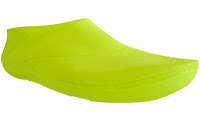 I have written previously about the fact that I enjoy laying in a hammock and often bring a hammock with me on day hikes where I'm less concerned about pack weight.
I have written previously about the fact that I enjoy laying in a hammock and often bring a hammock with me on day hikes where I'm less concerned about pack weight.Hammocking to me is strictly for relaxing as I simply can't sleep in them. I don't know why, but I've just never been successful even though I'm comfortable. Truth be told, otherwise I think they are a great idea and very practical for the areas where I hike. As previously mentioned, I've owned and/or tried just about every hammock on the market and ultimately had a custom 11" Traveler made by Brandon Waddy with Warbonnet Outdoors (www.warbonnetoutdoors.com).
After having it for several months now, I decided I wanted to have a tarp because often I like hanging in my backyard in poor weather and would like the option of the same if I choose to carry it with me hiking. I didn't need anything terribly fancy or overly weight conscious, but I did want something made well and potentially useful for other activities.
 Being that I didn't already own a rectangular tarp, I wanted something where I could fold in the ends to work as doors in situations where I was exposed to blowing snow or rain. I wanted something made of silnylon as I didn't need anything more expensive. I went with the largest option I could find considering the size of my hammock - a 10'x12' Winter Tarp by Outdoor Equipment Supplier (http://www.outdoorequipmentsupplier.com/). It was $135 and came in at 19.5oz.
Being that I didn't already own a rectangular tarp, I wanted something where I could fold in the ends to work as doors in situations where I was exposed to blowing snow or rain. I wanted something made of silnylon as I didn't need anything more expensive. I went with the largest option I could find considering the size of my hammock - a 10'x12' Winter Tarp by Outdoor Equipment Supplier (http://www.outdoorequipmentsupplier.com/). It was $135 and came in at 19.5oz.I've owned a couple of tarps from OEM and each product was simply superior. If you're looking for a manufacturer who doesn't cut corners, has properly engineered designs, uses solid fabric with competant manufacturing techniques, and who treats customers right - OEM is a great option.

I met Brian MacMillin, the owner of OEM several times over the years at Trail Days in Damascus VA. Brian has a great story. An Eagle Scout who simply wanted better gear, he started OEM while working on his B.S. in Mechanical Engineering. He is now a graduate student and working on the technolgies and philosphies that directly relate to his business (waterproof fabrics, how materials impact design, etc.). Fascinating stuff.
There isn't too much about the tarp I can say that I haven't already implied. It's a wonderful piece of gear with reinforced tie-outs that form doors nicely around my uncustomary 11' custom hammock. I've been in a couple driving rains and came away without any dampness whatsoever. It is really refreshing to be so protected and so comfortable. Having color options is a nice choice and the more robust nature of the manufacturing is perfect for hammocking. I sold a Warbonnet Outdoors Big Mamba Jamba for this option as I felt OEM offered a product that worked better for my needs.
































